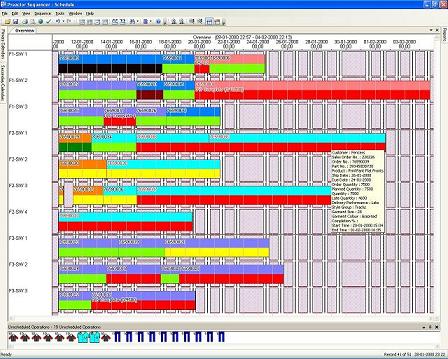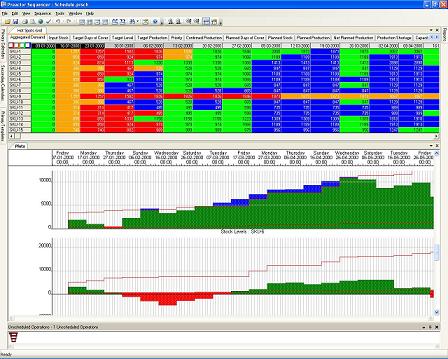Production Planning and Scheduling
DEFINITIONS
Let us first look at some definitions from APICS (American Production and Inventory Control Society) Dictionary.
Production Planning
A process to develop tactical plans based on setting the overall level of manufacturing output (production plan) and other activities to best satisfy the current planned levels of sales (sales plan or forecasts) while meeting general business objectives of profitability, productivity, competitive customer lead times, and so on, as expressed in the overall business plan. The sales and production capabilities are compared, and a business strategy that includes a sales plan, a production plan, budgets, pro forma financial statements, supporting plans for materials and workforce requirements, and so on, is developed.
One of its primary purposes is to establish production rates that will achieve management’s objective of satisfying customer demand by maintaining, raising, or lowering inventories or backlogs, while usually attempting to keep the workforce relatively stable. Because this plan affects many company functions, it is normally prepared with information from marketing and coordinated with the functions of manufacturing, sales, engineering, finance, materials, and so on.
Production Scheduling
The process of developing the production schedule – A plan that authorizes the factory to manufacture a certain quantity of a specific item. It is usually initiated by the production planning department.
Capacity Planning
The process of determining the amount of capacity required to produce in the future. This process may be performed at an aggregate or product-line level (resource requirements planning), at the master-scheduling level (rough-cut capacity planning), and at the material requirements planning level (capacity requirements planning).
Infinite Loading or Infinite Scheduling
Calculation of the capacity required at work centre in the time periods required regardless of the capacity available to perform this work.
Finite Loading or Finite Scheduling
Assigning no more work to a work centre than the work centre can be expected to execute in a given time period. The specific term usually refers to a computer technique that involves calculating shop priority revisions in order to level load operation by operation.
Drum-Buffer-Rope (DBR)
The theory of constraints method for scheduling and managing operations that have an internal constraint or capacity-constrained resource.
Forward Scheduling
A scheduling technique where the scheduler proceeds from a known start date and computes the completion date for an order, usually proceeding from the first operation to the last. Dates generated by this technique are generally the earliest start dates for operations.
Backward Scheduling
A technique for calculating operation start dates and due dates. The schedule is computed starting with the due date for the order and working backward to determine the required start date and/or due dates for each operation.
Advanced Planning and Scheduling
- Demand Planning
- Production Planning
- Production Scheduling
- Distribution Planning
- Transportation Planning
MORE INFORMATION ON PRODUCTION PLANNING AND PRODUCTION SCHEDULING
So successful has Opcenter’s breakthrough technology been that the number of companies using the product recently reached the 4,500 marks, more than any of our competitors. These companies are a mix of small and medium-sized as well as large corporations located in 88 countries.
Detailed Scheduling software is an important tool for many companies where it can have a major impact on the productivity of a process. In manufacturing, the purpose of scheduling is to minimize the production time and costs, by telling a production facility what to make, when, with which staff, and on which equipment. Production scheduling aims to maximize the efficiency of the operation and reduce costs.
The basic difference between planning software and scheduling software is that planning systems are ‚bucketed (monthly, weekly, daily) and cannot preserve operation sequences within the time bucket. True scheduling systems are bucketless, preserving sequencing, and capable of generating work-to or dispatch lists. Assignment of operation to a resource is a key function to achieving operational efficiency and optimizing performance.
Detailed scheduling uses a shorter time horizon and a much more detailed process route than a planning system.‚ Typically the input would be manufacturing orders which have a process route associated with each defining the operation steps to make the product.‚ The user then can load the orders onto individual resources using scheduling rules and interact with the schedule using the Gantt charts and plots that are generated.‚ A typical output would be a dispatch list for each resource.
An important feature of any scheduling tool is the ability to customize it to meet the unique needs of each application.‚ Templates can help to get the user to 80% of the requirements but to get the last 20% it's important to be able to tailor the tool to fit.


The available capacity is also entered through a calendar system set up in either daily or weekly mode for each resource, where resources may be departments, cells, plants or entire factories.
The planner can then use the system to change planning parameters and capacity in each period to see the impact on deliveries, stock levels, and capacity utilization over the planning horizon.